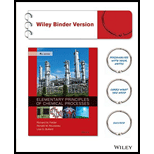
Concept explainers
(a)
Interpretation:
The flowchart for the given process is to be drawn and labelled. Also, degree of freedom analysis on the process is to be done.
Concept introduction:
A flowchart is the complete representation of a process through boxes or other shapes which represents process units and arrows that represents the input and output of the process. The flowchart must be fully labelled to infer important data about the process involved.
Degree of freedom analysis is the procedure to analyze any missing information needed for material balance calculations. The procedure involves complete labelling of the flowchart representing the process and then determining number of unknown variables
Mathematically, degree of freedom
…… (1)
(b)
Interpretation:
The equations for the unknown variables are to be written in order and the accounted variable in each equation is to be encircled.
Concept introduction:
In a system, a conserved quantity (total mass, mass of a particular species, energy or momentum) is balanced and can be written as:
Here, ‘input’ is the stream which enters the system. ‘generation’ is the term used for the quantity that is produced within the system. ‘output’ is the stream which leaves the system. ‘consumption’ is the term used for the quantity that is consumed within the system. ‘accumulation’ is used for the quantity which is builds up within the system.
All the equations which are formed are then solved simultaneously to calculate the values of the unknown variables.
For binary mixture in vapor-liquid equilibrium, Raoult’s law states that,
…… (2)
Here,
Antoine equation is used to determine the vapor pressure of any substance at the given temperature by the equation:
…… (3)
Here,
An ideal gas is the gas which obeys ideal gas laws which is a simplified equation of states.
A real gas behaves as an ideal gas at higher temperature and lower pressure. At STP, a mole of an ideal gas has a volume of
(c)
Interpretation:
The final temperature, composition of the liquid products, and the molar flow rates of the liquid and vapor product streams are to be calculated.
Concept introduction:
In a system, a conserved quantity (total mass, mass of a particular species, energy or momentum) is balanced and can be written as:
Here, ‘input’ is the stream which enters the system. ‘generation’ is the term used for the quantity that is produced within the system. ‘output’ is the stream which leaves the system. ‘consumption’ is the term used for the quantity that is consumed within the system. ‘accumulation’ is used for the quantity which is builds up within the system.
All the equations which are formed are then solved simultaneously to calculate the values of the unknown variables.
For binary mixture in vapor-liquid equilibrium, Raoult’s law states that,
…… (2)
Here,
Antoine equation is used to determine the vapor pressure of any substance at the given temperature by the equation:
…… (3)
Here,
An ideal gas is the gas which obeys ideal gas laws which is a simplified equation of states.
A real gas behaves as an ideal gas at higher temperature and lower pressure. At STP, a mole of an ideal gas has a volume of
(d)
Interpretation:
The assumptions made during the calculations which may induce some errors in the calculations are to be listed.
Concept introduction:
A gas behaves as an ideal gas at high temperature and low pressure. Any deviation from this leads to the real gases.
Want to see the full answer?
Check out a sample textbook solution
Chapter 6 Solutions
Elementary Principles of Chemical Processes, Binder Ready Version
 Introduction to Chemical Engineering Thermodynami...Chemical EngineeringISBN:9781259696527Author:J.M. Smith Termodinamica en ingenieria quimica, Hendrick C Van Ness, Michael Abbott, Mark SwihartPublisher:McGraw-Hill Education
Introduction to Chemical Engineering Thermodynami...Chemical EngineeringISBN:9781259696527Author:J.M. Smith Termodinamica en ingenieria quimica, Hendrick C Van Ness, Michael Abbott, Mark SwihartPublisher:McGraw-Hill Education Elementary Principles of Chemical Processes, Bind...Chemical EngineeringISBN:9781118431221Author:Richard M. Felder, Ronald W. Rousseau, Lisa G. BullardPublisher:WILEY
Elementary Principles of Chemical Processes, Bind...Chemical EngineeringISBN:9781118431221Author:Richard M. Felder, Ronald W. Rousseau, Lisa G. BullardPublisher:WILEY Elements of Chemical Reaction Engineering (5th Ed...Chemical EngineeringISBN:9780133887518Author:H. Scott FoglerPublisher:Prentice Hall
Elements of Chemical Reaction Engineering (5th Ed...Chemical EngineeringISBN:9780133887518Author:H. Scott FoglerPublisher:Prentice Hall
 Industrial Plastics: Theory and ApplicationsChemical EngineeringISBN:9781285061238Author:Lokensgard, ErikPublisher:Delmar Cengage Learning
Industrial Plastics: Theory and ApplicationsChemical EngineeringISBN:9781285061238Author:Lokensgard, ErikPublisher:Delmar Cengage Learning Unit Operations of Chemical EngineeringChemical EngineeringISBN:9780072848236Author:Warren McCabe, Julian C. Smith, Peter HarriottPublisher:McGraw-Hill Companies, The
Unit Operations of Chemical EngineeringChemical EngineeringISBN:9780072848236Author:Warren McCabe, Julian C. Smith, Peter HarriottPublisher:McGraw-Hill Companies, The





